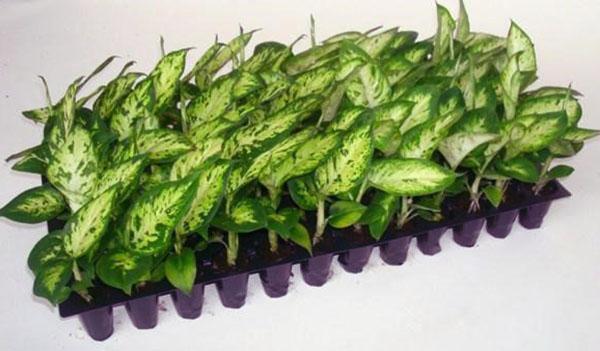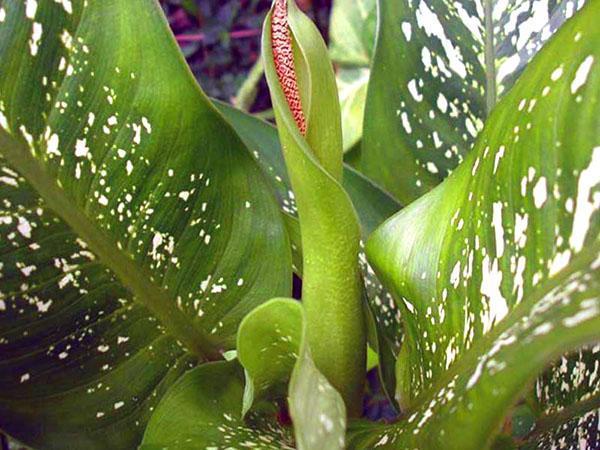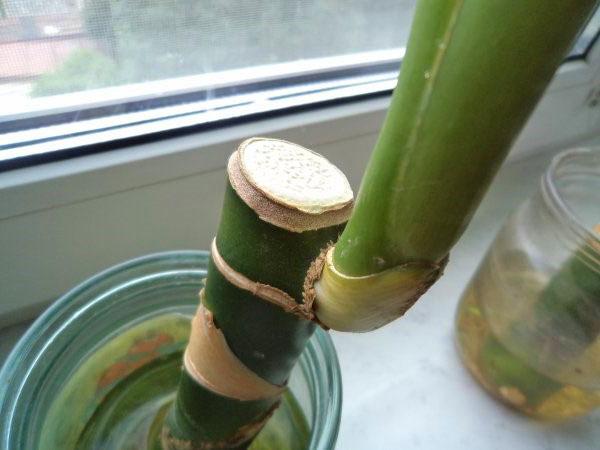Reproduction in indoor conditions of an amazing dieffenbachia
 Can a Tropicana give offspring in unusual conditions? Dieffenbachia, whose reproduction in nature has been worked out for centuries, in captivity gives offspring easily. You can get a new bush of a rapidly growing flower over the summer. Seed and vegetative propagation is used.
Can a Tropicana give offspring in unusual conditions? Dieffenbachia, whose reproduction in nature has been worked out for centuries, in captivity gives offspring easily. You can get a new bush of a rapidly growing flower over the summer. Seed and vegetative propagation is used.
How to propagate dieffenbachia at home

Methods of vegetative propagation of the tropicana
Dieffenbachia is a poisonous plant. Its milky juice can cause laryngeal edema, suffocation. The consequence of poisoning can be blindness. The plant is especially dangerous for children and animals. When working with it, you should protect open areas of the body, wear glasses and rubber gloves.
 Getting new plants by rooting various parts of the ground bush is considered a vegetative. At the same time, special conditions are created for the germination of roots. It is necessary that the part located in damp earth or water does not rot, but gives the rudiments of life, small roots. For reproduction use:
Getting new plants by rooting various parts of the ground bush is considered a vegetative. At the same time, special conditions are created for the germination of roots. It is necessary that the part located in damp earth or water does not rot, but gives the rudiments of life, small roots. For reproduction use:
- stem cuttings;
- tops;
- air layering.
If rooting is carried out in the ground, then you need to use peat and sand in equal proportions. In this case, the soil must be sterilized. The composition is poured into a wide bowl, moistened with distilled water. During germination, the substrate temperature should be 25-27 degrees, which can be done with a bottom thermostat. Cover the greenhouse with a jar or bag, but be sure to ventilate and monitor the humidity.
 Dieffenbachia propagation by cuttings includes a number of preparatory operations.
Dieffenbachia propagation by cuttings includes a number of preparatory operations.
The best rooting will be when the planting material is laid in spring. If the cuttings are taken without leaves, then they are 20-15 cm long, the cuts are treated with crushed coal and Kornevin, laid horizontally, sprinkled with earth up to half. Then new leaves will appear all over the stem in 10 months. You need to plant the whole branch of Dieffenbachia, reproduction is carried out without cutting it into shares. You can plant a long stalk for rooting at an angle, with a depression of no more than 2 cm at one end.
 Cuttings with leaves can be germinated in water or in a school. But at the same time, you should wipe and moisten the leaves, ventilate the greenhouse to prevent the appearance of mold. The roots that appear should grow up to 2-3 cm in length. There must be activated carbon in the water. Roots germinate by water method within two months.
Cuttings with leaves can be germinated in water or in a school. But at the same time, you should wipe and moisten the leaves, ventilate the greenhouse to prevent the appearance of mold. The roots that appear should grow up to 2-3 cm in length. There must be activated carbon in the water. Roots germinate by water method within two months.
It is better to root the tops in water. The lower stem petioles root better in the ground. The middle part of the shoot forms roots equally well in water and substrate.
Air layering can be obtained if the dieffenbachia trunk is cut in several places and spacers are inserted into the slots. Treat open places with Kornevin, wrap them in a damp moss pillow. In open sections, located 5 mm apart along the branch, awakened buds will give roots.After that, the branch is cut off and planted in the prepared substrate.
How to propagate dieffenbachia after grafting
 The emerging rudiments of the root system will not be able to provide food for the terrestrial part of the plants. They need to be transplanted into nutrient soil and rooted. For planting, a spacious pot is chosen, the drainage layer is laid high so that excess water can be easily filtered out. The best soil will be an acidic mixture for growing decorative leaf crops. When dieffenbachia propagates at home, a young tender plant is watered only with warm boiled water, adding a root formation stimulator. A sign that the roots have begun to work will be building up greenery at the tops of the shoots.
The emerging rudiments of the root system will not be able to provide food for the terrestrial part of the plants. They need to be transplanted into nutrient soil and rooted. For planting, a spacious pot is chosen, the drainage layer is laid high so that excess water can be easily filtered out. The best soil will be an acidic mixture for growing decorative leaf crops. When dieffenbachia propagates at home, a young tender plant is watered only with warm boiled water, adding a root formation stimulator. A sign that the roots have begun to work will be building up greenery at the tops of the shoots.
 All these breeding methods preserve the characteristics of the mother plant. After cutting off the planting material, a stump remains from the old bush, which rises 10 cm above the ground.If it is regularly watered, preventing the clod of earth from completely drying out, stepchildren will grow on the column, giving rise to a new bush. True, you should be patient. The process takes several months.
All these breeding methods preserve the characteristics of the mother plant. After cutting off the planting material, a stump remains from the old bush, which rises 10 cm above the ground.If it is regularly watered, preventing the clod of earth from completely drying out, stepchildren will grow on the column, giving rise to a new bush. True, you should be patient. The process takes several months.
 Propagating dieffenbachia is exciting. It grows quickly, the leaves are decorative and develop one after another. For greater clarity, the main techniques for breeding dieffenbachia on video.
Propagating dieffenbachia is exciting. It grows quickly, the leaves are decorative and develop one after another. For greater clarity, the main techniques for breeding dieffenbachia on video.